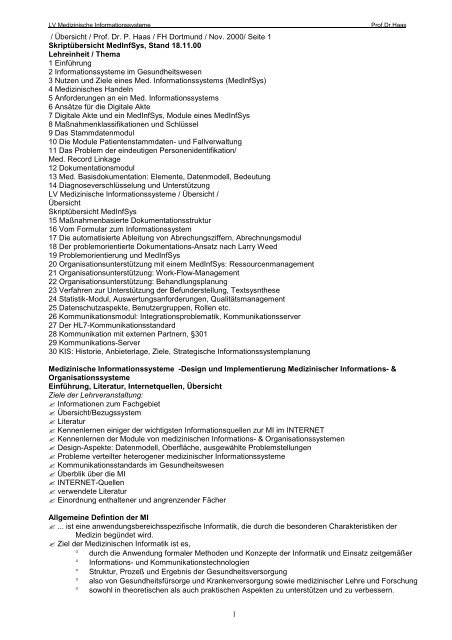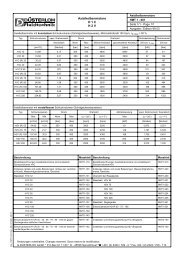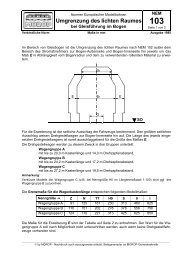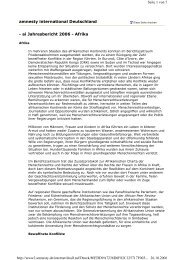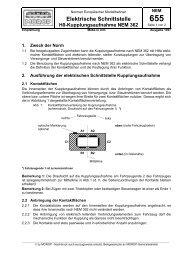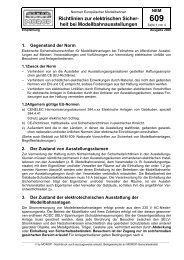1 / Übersicht / Prof. Dr. P. Haas / FH Dortmund / Nov. 2000/ Seite 1 ...
1 / Übersicht / Prof. Dr. P. Haas / FH Dortmund / Nov. 2000/ Seite 1 ...
1 / Übersicht / Prof. Dr. P. Haas / FH Dortmund / Nov. 2000/ Seite 1 ...
Sie wollen auch ein ePaper? Erhöhen Sie die Reichweite Ihrer Titel.
YUMPU macht aus Druck-PDFs automatisch weboptimierte ePaper, die Google liebt.
LV Medizinische Informationssysteme <strong>Prof</strong>.<strong>Dr</strong>.<strong>Haas</strong><br />
/ <strong>Übersicht</strong> / <strong>Prof</strong>. <strong>Dr</strong>. P. <strong>Haas</strong> / <strong>FH</strong> <strong>Dortmund</strong> / <strong>Nov</strong>. <strong>2000</strong>/ <strong>Seite</strong> 1<br />
Skriptübersicht MedInfSys, Stand 18.11.00<br />
Lehreinheit / Thema<br />
1 Einführung<br />
2 Informationssysteme im Gesundheitswesen<br />
3 Nutzen und Ziele eines Med. Informationssystems (MedInfSys)<br />
4 Medizinisches Handeln<br />
5 Anforderungen an ein Med. Informationssystems<br />
6 Ansätze für die Digitale Akte<br />
7 Digitale Akte und ein MedInfSys, Module eines MedInfSys<br />
8 Maßnahmenklassifikationen und Schlüssel<br />
9 Das Stammdatenmodul<br />
10 Die Module Patientenstammdaten- und Fallverwaltung<br />
11 Das Problem der eindeutigen Personenidentifikation/<br />
Med. Record Linkage<br />
12 Dokumentationsmodul<br />
13 Med. Basisdokumentation: Elemente, Datenmodell, Bedeutung<br />
14 Diagnoseverschlüsselung und Unterstützung<br />
LV Medizinische Informationssysteme / <strong>Übersicht</strong> /<br />
<strong>Übersicht</strong><br />
Skriptübersicht MedInfSys<br />
15 Maßnahmenbasierte Dokumentationsstruktur<br />
16 Vom Formular zum Informationssystem<br />
17 Die automatisierte Ableitung von Abrechungsziffern, Abrechnungsmodul<br />
18 Der problemorientierte Dokumentations-Ansatz nach Larry Weed<br />
19 Problemorientierung und MedInfSys<br />
20 Organisationsunterstützung mit einem MedInfSys: Ressourcenmanagement<br />
21 Organisationsunterstützung: Work-Flow-Management<br />
22 Organisationsunterstützung: Behandlungsplanung<br />
23 Verfahren zur Unterstützung der Befunderstellung, Textsysnthese<br />
24 Statistik-Modul, Auswertungsanforderungen, Qualitätsmanagement<br />
25 Datenschutzaspekte, Benutzergruppen, Rollen etc.<br />
26 Kommunikationsmodul: Integrationsproblematik, Kommunikationsserver<br />
27 Der HL7-Kommunikationsstandard<br />
28 Kommunikation mit externen Partnern, §301<br />
29 Kommunikations-Server<br />
30 KIS: Historie, Anbieterlage, Ziele, Strategische Informationssystemplanung<br />
Medizinische Informationssysteme -Design und Implementierung Medizinischer Informations- &<br />
Organisationssysteme<br />
Einführung, Literatur, Internetquellen, <strong>Übersicht</strong><br />
Ziele der Lehrveranstaltung:<br />
Informationen zum Fachgebiet<br />
<strong>Übersicht</strong>/Bezugssystem<br />
Literatur<br />
Kennenlernen einiger der wichtigsten Informationsquellen zur MI im INTERNET<br />
Kennenlernen der Module von medizinischen Informations- & Organisationssystemen<br />
Design-Aspekte: Datenmodell, Oberfläche, ausgewählte Problemstellungen<br />
Probleme verteilter heterogener medizinischer Informationssysteme<br />
Kommunikationsstandards im Gesundheitswesen<br />
Überblik über die MI<br />
INTERNET-Quellen<br />
verwendete Literatur<br />
Einordnung enthaltener und angrenzender Fächer<br />
Allgemeine Defintion der MI<br />
... ist eine anwendungsbereichsspezifische Informatik, die durch die besonderen Charakteristiken der<br />
Medizin begündet wird.<br />
Ziel der Medizinischen Informatik ist es,<br />
° durch die Anwendung formaler Methoden und Konzepte der Informatik und Einsatz zeitgemäßer<br />
° Informations- und Kommunikationstechnologien<br />
° Struktur, Prozeß und Ergebnis der Gesundheitsversorgung<br />
° also von Gesundheitsfürsorge und Krankenversorgung sowie medizinischer Lehre und Forschung<br />
° sowohl in theoretischen als auch praktischen Aspekten zu unterstützen und zu verbessern.<br />
1
LV Medizinische Informationssysteme <strong>Prof</strong>.<strong>Dr</strong>.<strong>Haas</strong><br />
Aufgaben / Aspekte des Fachgebietes<br />
Die 4 prinzipiellen Ausrichtungen der MI (s. Skript LV Einführung in die MI)<br />
Bsp. AG- / PG-Gliederung des FB MI der GMDS<br />
Spezielle methodische Aspekte<br />
Medizinische Dokumentation<br />
med. Klassifikations- und Schlüsselsysteme<br />
Biostatistische Methoden<br />
mathematische Verfahren zur Signal- und Bildverarbeitung<br />
Methoden-/Anwendungsmatrix<br />
Literaturübersicht<br />
INTERNET-Quellen in der Medizin & MI<br />
explosionsartige Entwicklung in den vergangenen 2 Jahre<br />
Mehrere Klassen von Anbietern<br />
spezielle Dienstanbieter für die Medizin<br />
Fachgesellschaften, Verbände und Organisationen<br />
Gesundheits-Industrie<br />
Hochschulen<br />
verschiedene Ziele<br />
Information der Patienten<br />
Information der Fachöffentlichkeit<br />
Werbung und Einflußnahme --> s. beigefügte HTML-Datei<br />
Enthaltene und angrenzende Fächer<br />
Medizinische Informatik<br />
Health Informatics („Gesundheitsinformatik“, „Gesundheitstelematik“)<br />
Telemedizin<br />
Krankenhausinformatik<br />
Pflege-Informatik<br />
Medizintechnik<br />
Bio-Informatik<br />
Bionik<br />
LE 2: Informationssysteme im Gesundheitswesen<br />
Ziele der LE:<br />
Überblick Informationssysteme im Gesundheitswesen<br />
Topologie von Krankenhausinformationssystemen<br />
System-Klassifikation<br />
• Krankenhausinformationssystem (KIS)<br />
rechnergestütztes KIS als Summe aller eingesetzten und kooperierenden Anwendungssysteme im<br />
Krankenhaus<br />
Stellt „Mikrokosmos“ dar, der alle Problemstellungen und Lösungsansätze auch für andere medizinische<br />
Informationssysteme sowie vernetzte Systeme im gesamten Gesundheitswesen enthält<br />
• Verwaltungssystem<br />
Umfaßt alle Einzel-Systeme, die in der Verwaltungund der Versorgung zum Einsatz kommen<br />
wenig medizinischer Bezug<br />
Trend zu „industriellen“ Lösungen<br />
nicht unbedingt krankenhausspezifisch (Ausnahme: Apothekensystem)<br />
• Medizinische Fachabteilungssysteme (1)<br />
Informatiklösungen zur umfassenden Unterstützung der medizinischen<br />
- Dokumentation<br />
- Organisation und<br />
- Kommunikation<br />
einer medizinischen Fachabteilung unter Berücksichtigung aller nachgeordneten medizinischen und mikroökonomischen<br />
Verwendungszusammenhänge der Daten<br />
Übliche Fachabteilungsgliederung s. Skript<br />
2
LV Medizinische Informationssysteme <strong>Prof</strong>.<strong>Dr</strong>.<strong>Haas</strong><br />
• Medizinische Fachabteilungssysteme (2)<br />
Gemeinsamkeiten aller Fachabteilungen<br />
Basisdokumentation (klinischer Minimaldatensatz)<br />
minimale Kernprozesse (Diagnosemeldung nach SGB V, stationäre Verlegung etc.)<br />
Arztbriefschreibung<br />
Domain- und Basisdaten (ICD, einweisende Ärzte etc.)<br />
Unterschiede<br />
spezifische Fachabteilungsdokumentation<br />
spezifische organisatorische Prozesse<br />
relevante Wissensbasen<br />
• Medizinisches Pflegeinformationssystem<br />
Informatiklösung zur umfassenden Unterstützung der medizinischen Dokumentation, Organisation und<br />
Kommunikation in der Pflege mit z.B.<br />
° Pflegeanamnese<br />
° Pflegeplanung<br />
° Pflegedokumentation<br />
° Pflegestandards<br />
° Kurvenblatt<br />
° Auswertungen für Qualitätssicherung<br />
• Medizinische Leistungsstellensysteme<br />
spezielle für die Unterstützung der Dokumentation und Organisation bestimmter Leistungsstellen entwickelte<br />
Informationssysteme mit Integration medizin-technischer Komponenten<br />
Beispiele:<br />
° Laborinformationssysteme<br />
° Blutbanksysteme<br />
° Radiologie/PACS-Systeme<br />
° Operations(OP)-Dokumentationssysteme<br />
° usw....<br />
• Medizinisches Kommunikationssystem<br />
spezielle für die innerbetriebliche Leistungskommunikation entwickelte Software-Systeme zum Erfassen<br />
von Leistungsanforderungen und für die Befundrückmeldung. Zumeist geringe funktionale Bandbreite, im<br />
Wesentlichen Formularverwaltung mit einfachen Statusinformationen und Versendefunktionen<br />
• Informationssysteme im Gesundheitswesen / Medizinische Teillösungen<br />
Ambulanzverwaltung<br />
Privatabrechnung<br />
Dokumentenverwaltung<br />
Archivverwaltung<br />
Qualitätsmanagement<br />
Arzneimitteldatenbank<br />
Dienstplanung<br />
usw.<br />
• Kommunikationsserver<br />
spezielle für die Kopplung von heterogenen Systemen entwickelte Software, mit der es möglich wird,<br />
verschiedene (medizinische) Anwendungssysteme mittels Kommunikationsverbindungsdefinitionen<br />
hardware- und softwaretechnisch miteinander zu koppeln und Daten austauschen zu lassen<br />
• Informationssysteme im Gesundheitswesen / Problemstellung, Fragen<br />
Welche Gemeinsamkeiten haben Medizinische Informationssysteme für Fachabteilungen, Leistungsstellen<br />
und Pflege?<br />
Gibt es ein gemeinsames Grundmodell, welches anwendungsspezifisch weiter ausgeprägt werden kann?<br />
Welcher Grad der Integration zwischen den einzelnen Systemen ist notwendig?<br />
3
LV Medizinische Informationssysteme <strong>Prof</strong>.<strong>Dr</strong>.<strong>Haas</strong><br />
LE 3: Nutzen und Ziele eines MedInfSys<br />
Ziele der LE:<br />
Bedeutung des MedInfSys im Gesamtzusammenhang<br />
Ziele eines MedInfSys<br />
Unterstützungsmöglichkeiten eines MedInfSys<br />
Zentrale Fragestellungen<br />
Welche generellen Ziele/Nutzen haben<br />
medizinische Informationssysteme<br />
Welche generellen Anforderungen sind zu<br />
berücksichtigen<br />
Gibt es Grundprinzipien für alle medizinischen<br />
Informationssysteme<br />
--> generisches System für (fast) alle<br />
medizinischen Anwendungsbereiche<br />
Welche Randbedingungen sind zu<br />
berücksichtigen<br />
Nutzen/ Ziele eines MedInfSys<br />
.. für die Handelnden (Ärzte, Pfleger ...)<br />
.. für den Patienten<br />
.. für eine ausgewählte Kranken-Population<br />
.. für die das System nutzende Gesundheitsversorgungseinrichtung<br />
.. für die Gesellschaft<br />
Primärziele eines MedInfSys<br />
Unterstützung des ärztlichen Handelns<br />
Unterstützung des pflegerischen Handelns<br />
Unterstützung des Qualitätsmanagements<br />
Unterstützung der Betriebsführung<br />
Vielfältige Sekundärziele eines MedInfSys<br />
Administrative Arbeit erleichtern<br />
v Patientendokumentation verfügbar machen<br />
Unnötige Untersuchungen vermeiden helfen<br />
Ermöglichung schneller Befundkommunikation<br />
den Handelnden vorhandes Wissen<br />
kontextsensitiv verfügbar machen<br />
Abrechnung automatisieren<br />
kontinuierliche Qualitätsüberwachung<br />
ermöglichen<br />
4
LV Medizinische Informationssysteme <strong>Prof</strong>.<strong>Dr</strong>.<strong>Haas</strong><br />
Handlungszyklus unterstützen mit ...<br />
Dokumentationsunterstützung z.B. durch<br />
Sammlung und teilformale Erfassung von patientenbezogenen medizinischen Informationen unter<br />
Berücksichtigung von Plausibilitäten<br />
Rückgriff auf vorhandene Dokumentation<br />
<strong>Übersicht</strong>liche Darstellung ggf. verschiedene Sichten auf die verfügbare Dokumentation<br />
Entscheidungsunterstützung z.B. durch<br />
° Retrieval von ähnlichen Fällen<br />
° Verfügbarmachung von vorhandenemFaktenwissen<br />
° Verfügbarmachung von Studienergebnissen<br />
° entscheidungsunterstützende Verfahren auf Basis<br />
° von medizinsichen Wissensbasen<br />
Strategieunterstützung z.B. durch<br />
Retrieval relevanter Behandlungsleitlinien<br />
Definition und Anwendung von Vorgehensmustern für Diagnostik und Therapie (z.B. Therapiepläne)<br />
Verfügbarmachung der Evidenz geplanter weiterer diagnostischer oder therapeutischer Maßnahmen<br />
Nebenwirkungs- und Kontraindikationshinweise<br />
Entscheidungsmonitoring z.B. durch<br />
° Überwachung der Durchführung geplanter Maßnahmen<br />
° Generierung neuer Erfahrungsmuster durch Soll/Ist-Analyse von Behandlungsplänen<br />
° wissensbasierte Generierung von Warnhinweisen<br />
° z.B. zu Kontraindikationen, individuellen Unverträglichkeiten, kritische<br />
Symptomkonstellationen etc.<br />
LE 4: Medizinisches Handeln<br />
Ziele der LE<br />
Kennenlernen genereller medizinischer Vorgehensweise<br />
Begriffsdefinitionen und Abgrenzungen<br />
Problematik der Entscheidungssituationen<br />
Medizinisches Handeln und Medizinische Dokumentation<br />
Medizinisches Handeln<br />
Vom Symptom zur Diagnose<br />
Das Sammeln und Scharfstellen der Symptome ist primäre Aufgabe !<br />
Die Selektion des Wesentlichen und die effektive Verwendung der gewonnenen Informationen bilden den<br />
Kern der ärztlichen Kunst !<br />
Medizinisches Handeln<br />
Medizinisches Handeln ist geprägt von ..<br />
diagnostischen oder therapeutischen<br />
Aktionen (sogenannten Maßnahmen)<br />
deren Ergebnisse bzw. Wirkungen - meist<br />
dokumentiert in einem Ergebnisdokument<br />
(Meßwerte, Textbefund, Kurve, Bild etc.)<br />
daraus resultierenden Handlungen<br />
und<br />
ungeplanten patientenindividuellen<br />
Ereignissen<br />
5
LV Medizinische Informationssysteme <strong>Prof</strong>.<strong>Dr</strong>.<strong>Haas</strong><br />
Konsequenzen der med. Handlungen<br />
Aus der Handlung selbst, oder deren<br />
Ergebnis (Dokument) oder aus der<br />
Interpretation dieses Dokumentes oder aus<br />
einem Ergeignis ergeben sich Konsequenzen<br />
wie z.B.<br />
Stellung einer neuen Verdachtsdiagnose<br />
(Teil-) Bestätigung einer Diagnose<br />
Verwerfen einer Verdachtsdiagnose<br />
Bedingungen für weitere Handlung(en)<br />
Durchführung weiterer Handlung(en)<br />
Besserung/Verschlechterung einer Beschwerde,<br />
eines Symptoms<br />
Beispiel Arterielle Hypertonie - Definition<br />
Chronische Hypertonie:<br />
dauernde Erhöhung des arteriellen Blutdruckes auf über 160 mmHg systolisch und über 95 mmHg<br />
diastolisch.<br />
Grenzwerthypertonie:<br />
° Blutdruck zwischen 140/90 und 160/95 mmHg.<br />
Labile Hypertonie:<br />
° überschießender Blutdruckanstieg auf physiologische oder psychische Belastungen.<br />
Maligne oder akzelerierte Hypertonie:<br />
° diastolischer Blutdruck über 120 - 130 mmHg, rasche Progredienz,<br />
Augenhintergrundveränderungen Stadium III-IV nach Thiel.<br />
Altershypertonie:<br />
° Erhöhung des systolischen Blutdruckes über 160 mmHg bei normalem diastolischen <strong>Dr</strong>uck und<br />
Alter über 65 Jahre.<br />
Beispiel Arterielle Hypertonie - Vorkommen<br />
Primäre Hypertonie (essentiell, Idlopathisch)<br />
Sekundäre Hypertonie<br />
Renal<br />
Renovaskulär<br />
Endokrin<br />
Morbus Conn<br />
Morbus Cushing<br />
Mineralokortikoidsyndrom<br />
Hyperthyreose<br />
Phäochromozytom<br />
Kardiovaskulär<br />
Medikamentös<br />
Neurogen<br />
6
LV Medizinische Informationssysteme <strong>Prof</strong>.<strong>Dr</strong>.<strong>Haas</strong><br />
Beispiel Arterielle Hypertonie - Diagnostik (1)<br />
Differentialdiagnostisches Vorgehen<br />
° Je jünger der Patient, je ausgeprägter der Hochdruck und je rascher die Progredienz, um so<br />
intensivere Diagnostik ist erforderlich, um operativ heilbare Formen (etwa 2-5% aller Hypertoniker)<br />
zu erfassen.<br />
Basisprogramm:<br />
° Obligat bei jedem Patienten mit chronisch-arterieller Hypertonie:<br />
1. Blutdruck-Messung<br />
° Blutdruck-Messung an mehreren Tagen, um emotionelle Blutdruck-Erhöhung (auch diastolisch)<br />
auszuschließen. Messung an beiden Armen und Beinen zur Erfassung vaskulärer Prozesse. Evtl.<br />
Messung am Fahrradergometer unter definierter Belastung.<br />
2. Auskultation<br />
° Herz, Abdomen und Palpation (Zystennieren, Tumoren).<br />
3. Spiegelung des Augenhintergrundes ("Gefäßspiegel")<br />
° Evtl. Hinweise auf Fundus hypertonicus.<br />
4. Urinuntersuchung<br />
° Zum Ausschluß bzw. Nachweis renaler Erkrankungen. Katecholaminbestimmung<br />
(Phäochromozytom?).<br />
5. Blutuntersuchungen<br />
° Blutbild, Kreatinin, Kalium, Blutlipoproteine und Blutzucker zum Ausschluß sekundärer<br />
Hypertonien und zur Erfassung von Risikofaktoren.<br />
6. Thorax-Röntgenbild<br />
° Linksherzhypertrophie, evtl. Zeichen einer linksventrikulären Insuffizien<br />
7. EKG und evtl. Echokardiographie<br />
° Linkstyp, evil. Hinweise auf Linksherzschädigung.<br />
8. Sonogramm<br />
° Zur Erfassung morphologischer Veränderungen an Nieren und Nierenarterien sowie Nebennieren<br />
(renale, renovaskuläre und durch Nebennierenadenome verursachte Hypertonie).<br />
° Ergänzende Untersuchungen<br />
9. I. v. Ausscheidungsurogramm<br />
° Zur Erfassung und Dokumentation renaler Veränderungen.<br />
10. Nierenangiographie<br />
° Bei jüngeren Patienten mit schwerer Hypertonie und guter Nierenfunktion zur Erfassung<br />
renovaskulärer Hypertonieform, auch bei normalem Ausfall des Basisprogramms. Zunehmend als<br />
digitale Subtraktionsangiographie durchgeführt.<br />
11. Computertomographie<br />
° Zur optimalen Erfassung morphologischer Veränderungen.<br />
12. Hormonuntersuchungen<br />
° Aldosacron, T, T., Kortisol, Katechohamine, z.T. auch gezielt in Verbindung mit phIebographischangiographischer<br />
Darstellung der Organe, Renin-Angiotensin.<br />
13. Isotopennephrogramm und seitengetrennte Clearance<br />
° Fakultative Zusatzuntersuchung bei Verdacht auf Harnabflußstörung, einseitige<br />
Funktionsstörungen oder Nierenarterienstenose.<br />
LE 5: Anforderungen an ein MedInfSys<br />
Ziele der LE<br />
Kennenlernen und Strukturierung der wichtigsten Anforderungen an ein MedInfSys<br />
Recommendations 1 Health Records Institute*<br />
Recommendation 1, Comitee on Improving the Patient Record, Insitute of Medicine<br />
1. The CPR contains a problem list that clearly delineates the patient’s clinical problems and the current status<br />
of each (e.g.,the primary illness is worsening, stable, or improving).<br />
2. The CPR encourages and supports the systematic measurement and recording of the patient’s health<br />
status and functional level to promote more precise and routine assessment of the outcomes of patient care.<br />
3. The CPR states the logical basis for all diagnoses or conclusions as a means of documenting the clinical<br />
rationale for decisions about the management of the patient’s care. (This documentation should enhance use<br />
of a scientific approach in clinical practise and assist the evolution of a firmer foundation for clinical<br />
knowledge.)<br />
4. The CPR can be linked with other clinical records of a patient- from various settings and time periods- to<br />
prvide a longitudinal (i.e., lifelong) record of events that may have influenced a person’s health. * Quelle: The<br />
Computer Based Patient Record, Institute of Medicine, National Academic Press<br />
7
LV Medizinische Informationssysteme <strong>Prof</strong>.<strong>Dr</strong>.<strong>Haas</strong><br />
5. The CPR system addresses patient data confidentiality comprehensively- in particular, ensuring that the<br />
CPR is accessible only to authorized individuals. (Although absolute confidentiality connot be guaranteed in<br />
any system, every possible practical and cost-effective measure should be taken to secure CPRs and CPR<br />
systems from unauthorized access or abuse.)<br />
6. The CPR is accessible for use in a timely way at any and all times by authorized individuals involved in<br />
direct patient care. Simulantaneous and remote access to the CPR is possible.<br />
7. The CPR system allows selective retrieval and formatting of information by usres. It can present customtailored<br />
“views” of the same information.<br />
8. The CPR system can be linked to both local and remote knowledge, litertature, bibliographic, or<br />
administrative databases ans systems (including those containing clinical practise guidelines or clinical<br />
decisions support capabilities) so that such information is readily avaiable to assist pracitioners in decision<br />
making.<br />
9. The CPR can assist and, in some instances, guide the process of clinical problem solving by providing<br />
clinicians with decision analysis tools, clinical reminders, prognostic risk assessment, and other clinical aids.<br />
10. The CPR supports structured data collection and stores information using a defined vocabulary. It<br />
adequately supports direct data entry by practitioners.<br />
11. The CPR can help individual practitioners and health care provider institutions manage and evaluate the<br />
quality and costs of care.<br />
12. The CPR is sufficiently flexible and expandable to support not only today’s basic information needs but<br />
also the evolving needs of each clinical specialty and subspecialty.<br />
Anforderungen an ein MedInfSys<br />
Anforderungen nach Fleck<br />
Im Rahmen des Forschungsprojektes PADKOM (PAtientenDaten-KOMmmunikation) der Projektgruppe<br />
Medizin am Deutschen Herzzentrum Berlin und der Technischen Universität Berlin als Teil des von der<br />
TELEKOM geförderten Forschungsprojektes BERKOM wurden umfangreiche Analysen zur<br />
Anforderungsermittlung<br />
durchgeführt. Ergebnisse in [Anforderungen an computergestützte medizinsche Arbeitsplätze, Fleck et. al.,<br />
Forschungsbericht Nr. 89-01, Dez. 1989].<br />
Grundlagen der Anforderungen waren:<br />
eine Systemanalyse der medizinischen Arbeitsabläufe im Deutschen Herzzentrum Berlin, bei der<br />
Dokumente und Arbeitsabläufe im Detail analysiert wurden. Daraus Aussagen über anfallende Datenmengen,<br />
zeitliche und örtliche Bedingungen der Verwendung dieser Daten, Engpässe etc.<br />
aus der Systemanalyse heraus entwickelte Szenarien für den DV-Einsatz im medizinischen Umfeld<br />
auf internationaler Ebene entwickelte Szenarien zur Verbesserung der med. Diagnostik und Therapie (z.B.<br />
EG-Förderprojekte wie das RACE-Projekt TELEMED)<br />
Allgemeine Grundsätze<br />
(1) Persönlicher Datenschutz muß gewährleistet sein<br />
(2) Funktionalität eines computergestützten Arbeitsplatzes muß aus der medizinischen Tätigkeit des Arztes in<br />
einer Klinik ableitbar sein<br />
Medizinsche Randbedingungen: Dateninterpretation<br />
(3) Patientenbezogene Daten müssen immer zusammen mit dem Kontext ihrer Entstehung gesehen werden<br />
(4) Patientenbezogene medinische Daten müssen jederzeit eindeutig der richtigen Person zugeordnet werden<br />
können<br />
Medizinsche Randbedingungen: Speicherung von Daten<br />
(5) Patientenbezogene medizinische Daten sollten am Ort aufgehoben (gespeichert) werden, wo sie im<br />
Rahmen der medizinischen Betreuung anfallen<br />
(6) Medizinische Daten sollten möglichst selten kopiert werden<br />
(7) Die Aufbewahrungszeit patientenbezogener medizinsicher Daten muß geregelt sein<br />
Medizinsche Randbedingungen: Zugangsberichtigung<br />
(8) Die Berechtigung des Zugangs zu patientenbezogenen Daten muß klar geregelt sein<br />
Grundsätze der Handhabung<br />
(9) Durch einen computergestützen Arbeitsplatz muß ein Arzt bei seiner Tätigkeit unterstützt werden<br />
(10) Die Benutzeroberfläche muß ergonomischen Erkenntnissen entsprechen<br />
(11) Die Bedienung muß weitgehend selbsterklärend sein<br />
(12) Die Bedienung muß einfach sein<br />
(13) Die Bedienung muß sicher sein<br />
(14) An computergestützen medizinischen Arbeitsplätzen ausgeführt Funktionen müssen möglichst<br />
weitgehend umkehrbar sein<br />
Funktionelle Leistungen<br />
(15) Die Reaktionszeit des Systems muß akzeptabel sein<br />
8
LV Medizinische Informationssysteme <strong>Prof</strong>.<strong>Dr</strong>.<strong>Haas</strong><br />
Verwaltungsfunktionen<br />
(16) Patientenbezogene Daten müssen bei Bedarf jederzeit einedeutig dem jeweiligen Patienten zugeordnet<br />
bzw. identifiziert werden können<br />
(17) Patientenbezogenen daten müssen jederzeit auffindbar d.h. lokalisierbar sein<br />
(18) Computergestützte medizinische Arbeitsplätze müssen das kurz-, mittel- und langfrsitige Speichern von<br />
med Daten ermöglichen<br />
Kommunikationsfuktionen<br />
(19) Patientenbezogene Daten müssen jederzeit an dem Ort wo sie benötigt werden, verfügbar sein d.h.<br />
kommunizierbar sein<br />
Verarbeitungsfunktionen<br />
(20) An einem medizinischen Arbeitsplatz müssen Daten aller folgenden Informationstypen bearbeitbar sein:<br />
Freitext, numerische Daten, Grafik, Festbild, Bewegtbild (Film), Audio, Video<br />
(21) Ein medizinischer Arbeitplatz muß es ermöglichen, logische Strukturen auf Daten verschiedener<br />
Informationstypen frei zu definieren und so entstandene Multimedia-Dokumente als Einheit funktionell zu<br />
bearbeiten und zu kommunizieren<br />
(22) Die Bearbeitung von Festbildern aller Art muß allen medizinischen Anforderungen bezüglich<br />
Bearbeitungsfunktionalität, Auflösung, Darstellungsgröße und -qualität genügen<br />
(23) Es muß ein universelles, flexibles Arbeiten mit Bildern aller Art ermöglicht werden: navigieren und<br />
zoomen bei Erhalt der Originaldaten<br />
Weitere wichtige Aspekte nach <strong>Haas</strong> (1)<br />
Zugänglichkeit:<br />
Zugänglichkeit bzw. “örtliche Verfügbarkeit” bedeutet, daß die Handlungsträger wie Arzt und Schwester in<br />
adäquater Weise Zugang zur digitalen Akte haben. Die herkömmliche Akte kann zur Bearbeitung überall<br />
hin mitgenommen werden. Es reicht also nicht aus, z.B. einen “Stationsbildschirm” im Stationszimmer<br />
verfügbar zu machen, sondern überall dort, wo die Akte gebraucht wird (Untersuchungsräume,<br />
Befundungsräume etc.), muß auch ein Zugang zur digitalen Akte möglich sein.<br />
Verfügbarkeit, Betriebssicherheit:<br />
Die zeitliche Verfügbarkeit muß 100 % betragen. D.h. keine Ausfallzeiten durch Sicherung, HW- oder SW-<br />
Wartung sind tolerierbar. Ausfallkonzepte sind unabdingbar<br />
Zuverlässigkeit<br />
Es muß sichergestellt sein, daß die Informationen in der digitalen Akte absolut zuverlässig sind. D.h. es darf<br />
durch keinerlei Vorgänge zu Informationsverfälschungen oder aber zu Informationsverlust kommen.<br />
Einmal erfaßte und freigegebene Informationen dürfen nicht mehr geändert werden, ggf. ist deren<br />
Fortschreibung erlaubt.<br />
Unbefristetheit<br />
Die digitale Akte muß eine den gesetzlichen Erfordernissen hinsichtlich der Aufbewahrungsfristen genügende<br />
Unbefristetheit besitzen. Weder Software-Release- noch Herstellerwechsel dürfen zur Beendigung der<br />
Datenverfügbarkeit im Routinebetrieb führen.<br />
Flexibilität, Erweiterbarkeit<br />
Die digitale Akte muß strukturell erweiterbar sein. Neue Formulare bzw. Datenelemente müssen prinzipiell<br />
ohne teure Zusatzentwicklungen möglich sein. Ihr Aufbau sollte so gestaltet sein, daß sie inkrementell<br />
erweitert werden kann.<br />
Vertraulichkeit<br />
Alle Vorkehrungen müssen getroffen sein, die sowohl dem Nutzer als auch dem Patienten die Sichheit geben,<br />
daß keine mißbräuchliche Nutzung möglich ist. Da digitale Akten sowohl Informationen über den Patienten als<br />
auch die Handelnden enthalten, sind diese doppelt schutzwürdig.<br />
Komplettheit, Vollständigkeit<br />
Alle in der konventionellen Akte enthaltenen Informationen müssen digital verfügbar sein. Kein Teil darf<br />
weiterhin - aus welchen organisatorischen Gründen auch immer - parallel auf Papier geführt werden müssen.<br />
Anwendbarkeit, Benutzbarkeit<br />
Die Nutzer müssen einen transparenten und intuitiven Zugang zur Akte und den darin enthaltenen<br />
Informationsobjekten haben. Die Präsentation muß diverse - z.T. kontextabhängige - Sichten auf die Akte<br />
ermöglichen. Das Navigieren darf nicht komplexer sein, als in einer Papierakte zu blättern.<br />
Kosten<br />
Die Investitions- und Folgekosten müssen in verantwortbarer Relation zum jährlichen Abteilungsbudget<br />
stehen. Dabei determiniert oftmals nicht die Größe der Abteilung, sondern deren Dokumentationskomplexität<br />
die Kosten.<br />
9
LV Medizinische Informationssysteme <strong>Prof</strong>.<strong>Dr</strong>.<strong>Haas</strong><br />
LE 6: Ansätze für die Digitale Krankenakte<br />
Ziele der LE<br />
Definition der digitalen Akte<br />
Abgrenzungen verschiedener Ansätze<br />
Implementierungsalternativen<br />
Digitale Akte und Implementierungsalternativen<br />
Konventionelle Krankenakte<br />
Aufbau und Struktur von konventionellen<br />
Krankenakten siehe LV „Einführung in die MI“<br />
.. ist Sammlung aller Behandlungsdokumente<br />
.. besteht aus mehr oder weniger festem<br />
Aktenkörper<br />
.. verschiedenste interne und externe (Archiv)<br />
Sortierungs- und Archivierungskonzepte<br />
Problematik der Sonderarchive (Röntgen ,<br />
EEG etc.) für verschiedene Medien,<br />
--> Medienbrüche<br />
Einfache Definition der digitalen Akte<br />
Die digitale Patientenakte ist die vollständig<br />
auf digitalen Speichermedien abgelegte<br />
Sammlung der medizinischen Informationen<br />
eines Patienten<br />
sowie die zugehörigen Interaktions- und<br />
Präsentationskomponente(n)<br />
Extreme Standpunkte sind demnach:<br />
Die Digitale Akte ....<br />
.. ist die Sammlung und Zugreifbarmachung aller Patientendokumente in „gescannter“ Form<br />
.. ist eine vollständig strukturierte und formalisierte Datensammlung aller (medizinischen)<br />
Behandlungsdaten<br />
--> Chaos der Dokumente<br />
--> Chaos der Attribute<br />
--> siehe Tafelbeispiele<br />
10
LV Medizinische Informationssysteme <strong>Prof</strong>.<strong>Dr</strong>.<strong>Haas</strong><br />
Implementierungsalternativen für Akte<br />
Dokumentenarchivierung- und -management<br />
im Mittelpunkt stehen die Dokumente wie sie heute schon existieren, einfache Ablagestruktur<br />
Hypertext-Ansatz (z.B. HTML-Lösung)<br />
einfache Navigations- und Verzweigungsmöglichkeiten zwischen den Dokumenten<br />
Informationssystem-Ansatz<br />
zusätzliche „Meta-Ebene“ mit medizinischen Informationen sowie zur Indizierung der Dokumente /<br />
Informationsobjekte<br />
Digitale Akte und Implementierungsalternativen / Erweiterte Definition<br />
Die digitale Patientenakte ist die vollständig auf digitalen Speichermedien abgelegte Sammlung der<br />
medizinischen Informationen eines Patienten in einer für die Erfüllung der Primärziele und der<br />
nachgeordneten Verwendungszwecke einer Krankenakte ausreichend strukturierten und formalisierten Form<br />
sowie die zugehörigen Interaktions- und Präsentationskomponente(n)<br />
Digitale Akte und Implementierungsalternativen<br />
Stufe 1: Automated Medical Record<br />
Stufen nach Med. Records Institut<br />
Almost all current computerization projects fall short of even being close to the vision of computer-based<br />
patient record systems. Due to a lack of consensus on terminology, we call the current stage of<br />
computerization the creation of automated medical records. This stage can best be described as still<br />
depending on paper-based medical records (although as much as 50% of patient information is computergenerated<br />
and stored in the form of computer printouts within the medical record). It must be acknowledged<br />
that in the ambulatory care field, a number of providers in the United States do put patient information on the<br />
computer or combine the clinical part with office management systems, but a closer look identifies such<br />
systems as not compliant with the criteria of the electronic patient record system as described below.<br />
Similarly, in some of the European countries, such as the United Kingdom, the Netherlands, and Sweden, a<br />
high number of general practitioners use the computer for patient information but do not always comply with<br />
signature requirements, or interoperabilility between general practitioners and hospitals, or other features of<br />
a computer-based patient record system.<br />
In the hospital environment, the following projects are part of automating functions around the paper-based<br />
medical record system: Admission/Discharge/Transfer (A/D/T) Systems Improved Capture of Patient<br />
Information Through Digital Dictation Systems Patient Accounting and its Linkage to Clinical Information<br />
Departmental Systems (such as Radiology Information Systems, Laboratory Information Systems, Pharmacy<br />
Information Systems, etc.) Order Entry/Results Reporting<br />
Some hospitals experiment with more advanced applications such as nursing/bedside computing, the<br />
creation of an enterprise-wide master patient index, the linkage of various parts into an enterprise-wide<br />
network, the development of interface engines, and operational imaging. All of these hospital automation<br />
projects are parallel to the paper-based patient record. In other words, they are part of the automated<br />
medical record system because the paper-based medical record is not changed by these systems.<br />
Stufe 2: Computerized Medical Record System<br />
Stufen nach Med. Records Institut<br />
The burden caused by paper-based medical record systems forces many providers to look for a solution that<br />
will digitize the medical record, address the space shortage most providers experience in record storage,<br />
and create an electronically available record. These objectives can be achieved by scanning paper-based<br />
documents into a document imaging system. Documents are created on paper, then indexed and scanned<br />
into a system that offers the same functions as paper-based systems (recording of the health care process<br />
and accessibility of previously recorded information). Again, for lack of consensus on terminology, we call it<br />
the computerized medical record system. (It is acknowledged that the American Health Information<br />
Management Association called document imaging systems “electronic medical record systems.”)<br />
Document imaging is based on optical storage technologies. Several hundred hospitals and providers have<br />
computerized all or part of their medical records through document imaging. The success rate of such<br />
systems has increased since 1993. Users consider the implementation of a document imaging system a<br />
success when: (1) care givers like and use it (due to instant retrieval), (2) indexing is adequate, and (3) it fits<br />
into the overall strategy of moving toward an electronic medical record system. It must be acknowledged that<br />
computerized medical records, such as the scanned records created in a document imaging system, offer<br />
today’s only method to computerize the medical record in form of a paperless system.<br />
However, it is important to note that in order for a medical record to be considered as part of the<br />
Computerized Medical Record System defined in Level 2, patient information must be scanned as one<br />
image. Document imaging methods such as optical character recognition (OCR) or intelligent character<br />
11
LV Medizinische Informationssysteme <strong>Prof</strong>.<strong>Dr</strong>.<strong>Haas</strong><br />
recognition (ICR) which scan text line by line, and allow the operator to change or delete text, are not<br />
acceptable under these Level 2 guidelines due to the user's ability to modify the information. The<br />
requirements of Electronic Medical Records described in Level 3 would apply to these imaging methods.<br />
Stufe 3: The Electronic Medical Record (page1)<br />
Stufen nach Med. Records Institut<br />
The electronic medical record is the upgraded version of the computerized medical record. Remember, the<br />
computerized medical record is achieved by using traditional medical records documents and images and<br />
transferring them into computer format. Complete documents with their legal attributes such as date and<br />
signature are converted as a whole from the paper medium to computer. The computerized medical record<br />
can be characterized as having essentially the same structure as the paper-based medical record. The<br />
electronic medical record, on the other hand, has the same scope of information but the information is<br />
rearranged for computer use. This means that it is still governed by the enterprise, may it be a hospital, a<br />
clinic, or other provider, an integrated delivery system, or a network. The enterprise has control over (1) how<br />
the patient is identified, (2) what information is recorded and how (terminology and structure), (3) retention<br />
period (similar or extended from the retention period of paper-based medical records), (4) security (including<br />
access control, electronic signatures, data integrity, and availability), and (5) functionality (determination of<br />
which functions the enterprise would like to have included). Within this context, an enterprise has to design a<br />
system that requires each care giver to use the computer for the accessing and for the recording of<br />
information. The goal of the electronic medical record is to make the various systems within the enterprise<br />
interoperable. Several criteria make up the electronic medical record.<br />
The first and difficult part is to create the enterprise’s infrastructure for appropriate capture, process and<br />
storage of information. For appropriate capturing, users need to be identified and given authorization<br />
according to their status. For instance, when a prescription is issued, the system has to ensure that it was<br />
issued by an authorized individual (a physician) and that it has not been changed. Second, the electronic<br />
medical record is arranged in a very different way than the medical record. Its structure is defined by<br />
computer processes rather than time-sequenced encounter documents. Third, it can be active when used<br />
within the computer-based patient record system. It must be remembered that the paper-based medical<br />
record is a passive storage device. The electronic patient record system can provide interactive aiding of the<br />
decision making processes by knowledge coupling, providing decision support, and many other functions.<br />
Stufe 3: The Electronic Medical Record (page 2)<br />
Stufen nach Med. Records Institut<br />
Fourth, the electronic medical record can seemlessly encompass and link financial and management<br />
functions. The success of electronic medical records depends on two system capabilities. One capability is<br />
user friendliness and user acceptance. The other is system design and functionality. Systems must combine<br />
these two capabilities, if they are to be appealing enough to convince care givers to switch from traditional<br />
ways of handling patient information to using a computer. The electronic medical record has the following<br />
essential functions:<br />
Enterprise-wide system of identifying all patient information available within the enterprise (enterprise-wide<br />
master-patient index). Making all enterprise-wide patient information available to all care givers. This<br />
involves data harmonization, data of warehousing, data mining techniques, interface engines, networking,<br />
etc. The purpose is to achieve a certain stage of interoperability within the enterprise.<br />
Implementing a common medical workstation approach that is to be used by all care givers. This involves an<br />
enterprise-wide consensus on common medical record software, structures and interfaces. The major task is<br />
to get physicians, nurses, and care givers to get used to using the computer during the encounter process<br />
for direct computer input or interaction.<br />
Creating a security system. In the absence of national legislation, an enterprise should define policies in<br />
regard to rights (privacy, patients’ right to access and alter patient information). This should lead to concrete<br />
confidentiality measures.<br />
Stufe 3: The Electronic Medical Record (page 3)<br />
Stufen nach Med. Records Institut<br />
Directly linked but (almost) more important are the system security features to be implemented. They<br />
include:<br />
Access Control: Either with secure passwords or (better) with a token and/or biometric access control<br />
system that is linked to a care giver's authentication system which classifies users according to their<br />
authorization to access information and to perform certain functions (physicians’ privileges and others).<br />
Electronic Signatures: Implementation of a system that allows the originator (care giver or device) to affix<br />
an electronic signature to an entry and detect if such an entry has been altered.<br />
Data Integrity: After the editing process, no information may be lost or altered in any way; corrections are<br />
made as amendments.<br />
12
LV Medizinische Informationssysteme <strong>Prof</strong>.<strong>Dr</strong>.<strong>Haas</strong><br />
Auditing: Complete auditing of user access to a record and any additions made to the record. (In the past,<br />
some people considered this an excessive demand as the auditing information can grow to a substantial<br />
volume of the record. However, this consideration has lost its value due to the low cost of computer storage.)<br />
Availability: The system has to be designed to be available 24 hours a day, 7 days a week.<br />
The electronic medical record system will be more attractive to users if it has the following additional<br />
functions. They are optional, but will represent standard components of the future electronic medical record<br />
system:<br />
Seamless integration and interaction with practice management systems, such as:<br />
Electronic eligibility determination<br />
Managed care functionality<br />
Electronic claims generation, submission, and payment functions Integration of expert software:<br />
Clinical reminders and other useful care support systems<br />
Diagnostic software such as problem knowledge couplers<br />
<strong>Dr</strong>ug management programs<br />
<strong>Dr</strong>ug selection (pointing to potential adverse drug reactions due to the patient’s history and/or<br />
comparing alternative drug by usage and/or price)<br />
Electronic prescriptions<br />
Practice guidelines<br />
Order entry systems Test result programs Programs for patient education<br />
Stufe 4:The Electronic Patient Record System<br />
Stufen nach Med. Records Institut<br />
The patient record has a wider scope of information than the medical record. It contains all health care<br />
related information concerning one person (such as traditional care givers, dentists and psychotherapists).<br />
The electronic patient record, (also called the computer-based patient record) therefore, focuses on the<br />
patient and contains information from one or more provider enterprises. In other words, the electronic patient<br />
record combines several enterprise-based electronic medical records concerning one patient and assembles<br />
a record that goes beyond the enterprise-based retention period. If acceptable to the patient, it may be a<br />
longitudinal record. The electronic patient record system has a number of prerequisites:<br />
Development of a national or international system of identifying all patient information available nationwide<br />
or worldwide. This involves a system where either central databases or provider organizations collect, store,<br />
safeguard, and distribute patient information.<br />
Making the information from a multitude of provider enterprises be part of this electronic patient record<br />
system. This involves a substantial level of patient information conformity and some levels of interoperability.<br />
Developing a national or international approach for common terminology, data sets, and structures.<br />
Creating an international consensus on security systems which allow electronic patient record systems to<br />
operate at a level of trust. This involves the security issues described above (access control, electronic<br />
signatures, data integrity, auditing, and availability).<br />
Extensive use of data and knowledge bases contribute to leverage in health care services between regions<br />
and the use of telemedicine.<br />
The electronic patient record system will enable a number of related systems:<br />
Public Health Information Systems<br />
Telemedicine<br />
Research<br />
Stufe 5:The Electronic Health Record<br />
Stufen nach Med. Records Institut<br />
The word patient implies that (s)he is in treatment with a provider of medical care, in most cases providers<br />
traditional medical care, however, nontraditional<br />
care (such as chiropractic, therapy,<br />
or acupuncture) may be included in a patient<br />
record. The more comprehensive collection of<br />
an individual's health information is the<br />
electronic health record. It differs from the<br />
electronic patient record in the unlimited<br />
amount of health information captured by care<br />
givers regarding a person. It includes wellness<br />
information and other health-related<br />
information that is not part of the traditional<br />
care delivery process. Wellness information<br />
could be captured personally by the individual,<br />
particularly in circumstances when the person<br />
is not seeing a health care professional for a<br />
13<br />
prolonged time. It might include data on behavioral<br />
activities such as smoking, exercising, dietary and<br />
drinking habits. Wellness information could also be<br />
captured by sports trainers, parents, therapists, and<br />
others. Therefore, the electronic health record system<br />
is maintained through the cooperation between the<br />
individual who controls his or her health information,<br />
and the care giver. In a futuristic view, individuals<br />
may maintain all their medical record information in<br />
addition to behavioral, dietary, drug-related, exercise<br />
related, environmental, and sexual information.<br />
They will share all or some of such information<br />
according to care needs. Existing software programs<br />
for individuals are the first step toward the electronic<br />
health record.
LV Medizinische Informationssysteme <strong>Prof</strong>.<strong>Dr</strong>.<strong>Haas</strong><br />
LE 7: Digitale Akte und ein MedInfSys<br />
Ziele der LE<br />
Digitale Krankenakte und ein MEDIS<br />
Module eines MEDIS<br />
Grundsätzliche Konstruktionsprinzipien<br />
Digitale Akte und MedInfSys<br />
Die digitale Akte ist (nur) Teil eines<br />
Medizinischen<br />
Informations- und Organisationssystems<br />
Akte = statische Verwaltung von<br />
Dokumenten und Zugriff auf diese unter<br />
verschiedensten Kriterien<br />
(-> Dokumentationskomponente)<br />
Informationssystem = unterstützt neben der<br />
Dokumentation auch die Organisation,<br />
Kommunikation und alle nachgeordneten<br />
Verwendungszwecke<br />
Basis für Entwurf von MedInfSys<br />
Ca. 20 Systemanalysen medizinischen<br />
Abteilungen mittels derer folgende Fragen<br />
geklärt wurden:<br />
wie kann ein invarianter Kern (also ein<br />
Basis-System) aussehen bzw. realisiert<br />
werden?<br />
wodurch und wie kann<br />
medizinisch/pflegerisches Handeln sinnvoll<br />
unterstützt werden?<br />
wie muß ein System aufgebaut sein, um es<br />
inkrementell erweitern zu können?<br />
wie kann eine Organisationsunterstützung<br />
sinnvoll in eine elektronische Akte integriert<br />
werden?<br />
Designtechnische Frage<br />
Welche Module braucht ein MedInfSys?<br />
Wie hängen diese Module voneinander ab?<br />
Welche „Querschnittsaspekte“ sind zu<br />
beachten?<br />
Konstruktionsprinzip MedInfSys<br />
Das Grundkonzept besteht in der<br />
Strukturierung der Akte als prinzipielle<br />
zeitorientierte Zusammenstellung aller<br />
patientenbezogenen Handlungen (Aktionen,<br />
Maßnahmen) und der diesen zugeordneten<br />
Dokumente respektive Informationsobjekte<br />
wie<br />
- Datenformulare<br />
- Befundtexte<br />
- Bilder, Graphiken, Verlaufskurven,<br />
Videos etc.<br />
... welche wiederum in Kombi-Objekte<br />
eingebaut sein<br />
können<br />
Maßnahmenbasierte Informationssysteme !!<br />
14<br />
<strong>Seite</strong> 10<br />
Digitale Akte und MEDIS<br />
Das „WAS“ = Med. Maßnahme/Prozedur<br />
-> Eine medizinische Prozedur ist eine Handlung<br />
eines<br />
Arztes oder einer medizinischen Hilfsperson an<br />
einem Patienten oder an einer Probe oder mit einem<br />
Schriftstück der Patientenbehandlung.<br />
Sie geht von einer bestimmten Indikation aus, um<br />
die Erkennung, Besserung, Linderung,<br />
Vorbeugung/Verhütung einer Erkrankung zu<br />
erreichen.<br />
(Im Folgenden wird nur noch von „Maßnahme“<br />
gesprochen)<br />
<strong>Seite</strong> 11<br />
Maßnahme als Kernobjekt des MedInfSys<br />
Maßnahme ist kleinste relevante (medizinische)<br />
Prozedur (diagnostisch/therapeutisch/sonstige)<br />
hat festes Raster für assoziierte<br />
Informationsobjekte (Texte, Bilder, Kurven etc.)<br />
ist die Basis für<br />
die medizinische Dokumentation<br />
das Behandlungsmanagement<br />
für Work-Flow-Steuerung<br />
Leistungserfassung (inkl. Planungs- und<br />
Verbrauchsstandards)<br />
Leistungsstatistik, Kostenrechnung und<br />
Abrechnung --> siehe Präsentationsbeispiele
LV Medizinische Informationssysteme <strong>Prof</strong>.<strong>Dr</strong>.<strong>Haas</strong><br />
Begriffliche Repräsentation von Maßnahmen<br />
Mittels einer Klassifikation<br />
° International Classification of Procedures in Medicine (ICPM)<br />
° Abrechungstarifwerke z.B. GOÄ, EBM etc.<br />
Jedoch Merke: Für die medizinische Dokumentation innerhalb DPA sind Klassifikationen ungeeignet !!<br />
Mittels einer Nomenklatur<br />
° Standardized Nomenclature of Medicine (SNOMED), Teil: Prozeduren<br />
° Read-Code<br />
° Eigenes Begriffssystem (Hausschlüssel)<br />
° Wichtig: Mnemotechnischer Deskriptor/Code<br />
15


